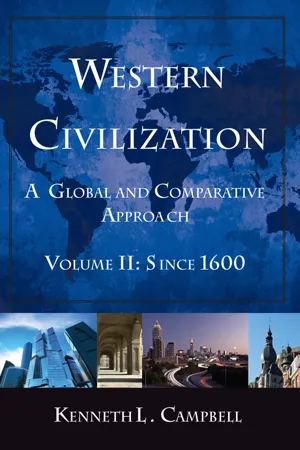History
Revolutions of 1848
The Revolutions of 1848 were a series of widespread uprisings and protests across Europe, driven by demands for political and social reforms. These revolutions were sparked by economic hardship, political repression, and a desire for national independence. Although they ultimately failed to achieve their goals, the events of 1848 had a lasting impact on European politics and society, paving the way for future reforms and nationalist movements.
Written by Perlego with AI-assistance
Related key terms
Related key terms
1 of 4
Related key terms
1 of 3
9 Key excerpts on "Revolutions of 1848"
- eBook - ePub
The History of Democracy
A Marxist Interpretation
- Brian S. Roper(Author)
- 2012(Publication Date)
- Pluto Press(Publisher)
7
The Revolutions of 1848–49 INTRODUCTIONIn 1848 the wave of revolutionary upheavals that swept across Western and Central Europe combined ‘the greatest promise, the widest scope, and the most immediate initial success, with the most unqualified and rapid failure’ (Hobsbawm, 1975: 37). But if these revolutions failed to achieve the creation of lasting republican democracies loosely modelled on those of the French and American revolutions, nonetheless they profoundly shaped the future course of European history, demolishing what remained of serfdom in Western and Central Europe, forcing monarchs to make liberal concessions that resulted in the prevalence and persistence of parliamentary forms of governance in which property owners were more widely represented than before 1848, and leading to the creation of constitutional, juridical and political arrangements that were significantly more favourable to the development of capitalism.This chapter outlines the wider historical context and underlying causes of the 1848 revolutions, provides a brief descriptive overview of the main events in France, Germany, Austro-Hungary and Italy, considers the June insurrection of workers in Paris, describes the conservative counter-revolution that destroyed the new governments created during the initial phase of the revolutions, and finally identifies the common features and historical legacy of these revolutions.BACKGROUND AND CAUSESThe Revolutions of 1848 took place in the wider historical context of the transition from feudalism to capitalism, uneven development of capitalism across Europe, the rapid growth of industrial capitalism in Britain that provided the economic underpinning for the global expansion of the British Empire, and finally the growing pressure on France and Germany to introduce capitalist relationships in agricultural production and to industrialise in order to be able to compete with Britain’s growing economic and military power. Much of this has been discussed earlier. Nonetheless, it is important to recognise that the persistence of serfdom and feudal relationships in Central and Eastern Europe was a major cause of discontent among serfs and peasants, and was viewed as increasingly anachronistic by the bourgeoisie, state officials and enlightened members of the nobility. In this context maintaining the extraction of surplus product from peasants and workers as feudalism declined and capitalism developed was a major challenge for the landowning nobility and emerging bourgeoisie (Mooers, 1991: 27–40). - eBook - ePub
Revolutions and the Revolutionary Tradition
In the West 1560-1991
- David Parker(Author)
- 2002(Publication Date)
- Routledge(Publisher)
7 The Revolutions of 1848John BreuillyIntroduction
By comparison with the ‘great’ revolutions such as those of 1789 or 1917, the Revolutions of 1848 exhibit at least four peculiar features. First, the revolutionary outbreak was not preceded by political crisis triggered by conflict within the ruling order (1789) or failure in war (1917). Europe was at peace – there was no major war between 1815 and 1854. The ruling order did not appear to be badly split. There were tensions and disputes but nothing like political crisis.Second, revolution spread rapidly across Europe. Revolution extended beyond France in the 1790s and Russia after 1917 but principally promoted by the original revolutionary regime. In 1848 there was no national centre; virtually every part of Europe between Britain and Russia experienced revolution ‘from within’.Third, the revolutionary situation lasted for a comparatively short time. By the summer of 1849 counter-revolution had triumphed. The ‘great’ revolutions lasted, in terms of regime instability and civil war, at least until 1795 in France and 1921 in the USSR. Finally, in the judgement of many contemporaries and historians, the 1848 revolutions ‘failed’. Although the revolutions of 1789 and 1917 did not realise their proclaimed ideals, few would deny that they transformed both society and state and that the post-revolutionary world is unimaginable without them. It is more difficult to argue that case for 1848.These four distinguishing features provide keys to understanding the Revolutions of 1848. First, I outline and analyse the initial revolutionary outbreak and ask why so many governments collapsed so quickly. Second, I characterise the new revolutionary situation and ask how this could lead on to further political conflict. Third, I consider three broad political strands – radicalism, liberalism and conservatism – and how these combined to enable rapid counter-revolution. Finally, I link these arguments to broader comparative historical treatments of the revolutions and suggest how one should evaluate their significance. - eBook - ePub
The Roots and Consequences of Civil Wars and Revolutions
Conflicts That Changed World History
- Spencer C. Tucker(Author)
- 2017(Publication Date)
- ABC-CLIO(Publisher)
The chief causes of the Revolutions of 1848 were liberalism and nationalism. Virtually all national groups who were under the sway of other nationalities sought independence, while the revolutionary leaders wanted expansion of the suffrage and written constitutions. Demands for socialism and democracy were also present.Widespread economic distress was a common factor. This began with the great Irish Potato Famine of 1845–1848. The worst famine in 19th-century Europe, it claimed perhaps 1.5 million lives, while another 2 million Irish emigrated. Europe as a whole experienced a heat wave followed by a drought and massive grain failures. By late 1847 what had begun as an agricultural crisis had grown into a widespread industrial and economic crisis. Factories shut down, and workers were laid off. Unemployment in Europe’s major cities soared to as much as 30–40 percent. The displaced and unemployed were thus ready and able to support revolutionary activity. The revolutionaries certainly understood the international nature of the repressive system in which rulers aided one another, so the success of a revolution in one location served as a stimulus to others.Although the Revolutions of 1848 occurred in short order and were widespread from Spain to Hungary (notable exceptions were Britain and Portugal in the west and Russia and Poland in the east of the continent), what is perhaps most remarkable about them is how easily they had occurred and how quickly they were reversed. A number of factors explain the latter. For one thing, the established regimes were found to be stronger than had been realized. Also, after the revolutionaries had taken power, sharp differences arose among the leaders themselves. Liberals found themselves at odds with democrats and Marxists. These differences certainly made it much easier for the conservatives and reactionaries to overturn the revolutions.The revolutionaries also proved incapable of sustaining mass public support. Much of Europe was still overwhelmingly rural and agricultural, and the peasantry was largely politically inert. The revolutionaries for the most part were also humanitarians who failed to do away with the opposition leaders. The latter for the most part retained control of the military establishments, as in Prussia and Austria. The Russian military could also be called upon to help crush revolution elsewhere. Economic recovery also helped remove the underpinnings of the revolutions. The 1848 harvests were good ones, and the national economies quickly rebounded. Employed workers had little time or energy for revolutionary activity. Finally, many religious people considered an outbreak of cholera that took place as a sign of divine judgement on revolutionary activity. - eBook - ePub
- Jean Berenger, C.A. Simpson(Authors)
- 2014(Publication Date)
- Routledge(Publisher)
CHAPTER ELEVEN The Revolution of 1848The revolution erupted violently in March 1848. The deep underlying forces which had been contained for so long during Metternichs government, suddenly rose to the surface and radically challenged the political as much as the social basis of the established order. The revolution of 1848 was liberal and national. It was critical for the future development of Danubian Europe and posed more problems than it could solve. A society which was still predominantly rural, dominated by the nobility and divided into numerous ethnolinguistic groups, was ill-prepared for a rapid transition to nation-states under the leadership of an unevenly developed bourgeoisie. The revolution also provoked a formidable reaction.THE IDEOLOGICAL FOUNDATIONS OF THE REVOLUTION 1
The ideas of the French Revolution had slowly infiltrated the Austrian monarchy, despite censorship and police vigilance, and had been adapted to the particular problems of individual nations.The German bourgeoisie had national and liberal aspirations. Its members, though, were a minority within the population and relied on the discontent roused by the government’s practices. Growing hatred for the police-state and its arbitrary methods was unquestionably one of the causes of the revolution. The bourgeoisie had lost patience with the obstinacy of the bureaucracy as well as the close surveillance of intellectual life. Artisans and intellectuals were most affected by these measures and formed the two most active groups at the heart of the movement.If those in power had renounced these oppressive practices, their subjects would probably have been satisfied with progressive reforms. Only a very few envisaged the nation participating actively in government and then only in terms of power being shared between the monarch and the elected assemblies. The doctrine of popular sovereignty had few supporters. Ministerial accountability before the Kammern was understood, not as the cornerstone of a regime, but as judicial accountability, the right of parliament to bring ministers before a tribunal in cases where they had violated the law. The German nation, which lived in Austria and the other states of the German Confederation, did not want to break with the world of dynasties and monarchical institutions, but rather wanted the establishment of a Rechtsstaat a state where law would be fully respected, an end put to all arbitrariness and the individual protected. It was, in fact, a continuation of the policies of the Aufklärung - eBook - ePub
- James Robinson, Charles Beard(Authors)
- 2017(Publication Date)
- Jovian Press(Publisher)
REVOLUTION OF 1848,—AUSTRIA, GERMANY, ITALY
~ THE FALL OF METTERNICHWhen Metternich heard of the February revolution in France all his old fears were revived. “Europe finds herself to-day,” he declared, “in the presence of a second 1793.” Great changes had, however, taken place during the fifty-five years which had elapsed since France first offered to aid other nations to free themselves from their “tyrants” and throw off the trammels of feudalism. In 1848 the principles proclaimed in the Declaration of the Rights of Man were accepted by the liberal parties which had come into existence in every state of Europe, and which were actively engaged in promoting the cause of popular government, a free press, equality of all before the law, and the abolition of the vestiges of the feudal system. Moreover the national spirit which had awakened during the Napoleonic Period was at work, and served more than anything else to excite opposition to the existing order. Lastly, the Industrial Revolution was quickening the thought and rousing the aspirations of the great mass of the population. Those who lived by the labor of their hands and were employed in the new industries which were rapidly developing now had their spokesmen, especially in France, and claimed the right to vote and to mold the laws to meet their particular interests. So in 1848 the rights of nations and of the laborer were added to the rights of man, which had constituted the main issue in 1793.In nearly every European country the liberals were encouraged by the successful February revolution in Paris to undertake to win, by violence if necessary, the reforms which they had so long been advocating. In England a body of workingmen, known as “Chartists,” made a desperate though futile effort to wring from Parliament the right to vote. A liberal ministry in Belgium was forced to reduce the amount of property which voters were required to possess, so that larger numbers of the people could participate in elections. The king of the Netherlands, in order to allay the discontent in his realm, agreed to a new and more democratic form of government. The Swiss, who had just passed through a civil conflict, swept away the constitution which had been adopted in 1814, and drew up a new one. The chief agitations of 1848,-if we except that in France, described in the preceding chapter, -occurred, however, in Germany, Italy, and the Austrian dominions, and it seems best to consider first the disturbances in Vienna, where Metternich had for forty years been doing his best to prevent any hint of change. - eBook - ePub
- Jeremy D. Popkin(Author)
- 2020(Publication Date)
- Routledge(Publisher)
13 The Revolution of 1848The Crisis of Bourgeois Society
Had the rapid economic and social changes of the 1830s and 1840s made a new revolutionary upheaval unavoidable in France? Alexis de Tocqueville, known for his book on American democracy, warned the Chamber of Deputies in January 1848 that the growing division between rich and poor in France and the spread of socialist ideas were making a revolution inevitable: “We are lulling ourselves to sleep over an active volcano.”1 When a popular uprising overthrew the July Monarchy a few weeks later, he gained a reputation as a prophet. But the Revolution of 1848 was a more complicated affair than the social civil war Tocqueville had warned of. It was made possible by widespread discontent among the educated classes as well as among the urban poor. The bloodiest moment of the Revolution—the war of barricades in Paris in June 1848—pitted the city’s underclass against equally poor soldiers recruited from the countryside. The revolutionary upheaval of 1848 ended with the establishment of a new authoritarian regime and the consolidation of the bourgeois social order, but it did plant the seeds for the eventual success of democratic republicanism in France.The February Revolution
The July Monarchy’s sudden collapse came as a surprise. A popular revolt would have seemed more likely in 1846 or 1847, when France had suffered a sharp economic depression. The boom fueled by the 1842 railroad-building program had burst in 1845, and agriculture had been hard hit by crop failures, especially the potato blight—the same plant disease that caused deadly famine in Ireland in 1846. Outbreaks of social violence, such as a riot in the provincial town of Buzançais in which a local bourgeois was massacred, had spurred widespread anxiety. Guizot’s government did little to alleviate the resulting unemployment and misery, but the economic crisis actually dampened worker agitation. Concern about eking out a living and fear of unemployment discouraged organized protests. - eBook - ePub
Western Civilization: A Global and Comparative Approach
Volume II: Since 1600
- Kenneth L. Campbell(Author)
- 2015(Publication Date)
- Routledge(Publisher)
The legacy of the French Revolution, the ongoing conflict between supporters and opponents of the revolutionary tradition, the forces of the Industrial Revolution, and the intellectual ferment that saw the rise of several new ideologies all culminated in a wave of revolution that swept across Europe in 1848. These were not the first revolutions of the post-Napoleonic period; the first wave of revolutions occurred in 1820 and included Spain, Portugal, and Italy. The Greek war for independence against the Ottoman Empire that began in 1821 was both a nationalist uprising against foreign rule and part of the same revolutionary wave of the post-Napoleonic period. Although repressive regimes across the continent crushed these revolutions (with the exception of the Greeks, who won their independence from the Ottomans in 1829), the revolutionaries and secret societies of this period sowed the seeds for future revolutions through the influence they had on young men such as Giuseppe Mazzini (1805–1872), a key Italian revolutionary in 1848.The next phase of revolution occurred in 1830 and included revolutions in France, Belgium, and Switzerland. In France, Charles X (r. 1824–1830) provoked widespread opposition with his July Ordinances of 1830, suspending freedom of the press, dissolving the newly elected Chamber of Deputies, placing further restrictions on the right to vote and the number of deputies in the chamber, and postponing new elections until September. Liberals regarded this as a blatant attempt to overthrow the constitution and to restore absolute authority to the crown. Almost immediately, revolutionaries threw up barricades in the streets of Paris. By July 30 Charles had rescinded the ordinances; on August 9 he abdicated his throne, saying he would rather be a woodcutter than a constitutional monarch such as the king of England. The French revolution of 1830 was thus spectacularly successful, resulting in the replacement of Charles by a cousin, Louis Philippe, who styled himself “King of the French.” In the same year, Belgium gained its independence and many Swiss cantons gained liberal constitutions as a result of their respective revolutions. - eBook - ePub
- William Carr, David Wetzel(Authors)
- 2023(Publication Date)
- Bloomsbury Academic(Publisher)
6 continued to grow in the provinces: that proved the base from which serious resistance was mounted when Napoleon III capped the counterrevolution with his coup d’état of December 2, 1851. So in Germany, while the success of the reaction in Vienna and Berlin was undoubtedly a grievous blow to the revolution, it did not stop the work of the Frankfurt Assembly nor did it foreclose the possibility of provincial political mobilization behind the constitution in 1849. The local focus of that final resistance can be seen as a weakness, but it was also a strength. It built on communalism that was such a salient feature of the Revolution, and it went with the grain of powerful local sentiment, whether the Rhinish dislike of Protestant core-Prussia, Badenese dislike of Prussian northerners, or Palatine dislike of Munich.Moreover, the revolution in Germany had demonstrably positive as well as negative aspects. It marked the entry of the German people into the political life of the nation, confirming the trends discernible in the 1840s. The actors of 1848, it is true, did not attempt to build up a mass following. Nevertheless, wider circles of the population began to take an interest in politics. Public discussion of constitutional and national problems acted as a catalyst destroying political apathy. Before 1848 only a small section of the German middle class was politically conscious; after the Revolution most of the middle class was conscious not only politically but nationally as well. This development was crucially important; it was to alter profoundly the structure of politics in Germany as in other European countries; furthermore, without the groundswell of public opinion favorable to unification, which the Revolution had created, the achievements of Bismarck in the 1860s would hardly have been possible. - eBook - ePub
- Michael D. Richards(Author)
- 2004(Publication Date)
- Routledge(Publisher)
Two other points might be made about revolution as another way of doing politics. First, revolutions produce a kind of demonstration effect, i.e. a revolution in one state may cause other states to take action to prevent the outbreak of revolution. Most frequently, this is in the form of counter-revolutionary activities, whether directed toward the population of the state fearful of revolutionary contagion, as in the case of Catherine the Great’s Russia in the 1790s, or against the revolutionary state itself. In other cases, however, it may lead to reform within the state in an attempt to head off the possibility of revolutionary change. One of the great ironies of Marxism is that Karl Marx and Friedrich Engels failed to see that other observers could do what they had done, determine the existence of certain trends in contemporary life and take action in response. Europeans in the second half of the nineteenth century paid at least minimal attention to social and economic issues, sponsoring reforms that gave many in the working classes the idea it would be better to work with the existing system than to try to overthrow it. In any case, after the Revolutions of 1848, the middle class, having noted the dangerous unpredictability of revolution, mostly opted for gradual change.Secondly, revolutions have sometimes come in waves, generally because similar circumstances elsewhere often elicit the same kinds of reactions as in the original locus of revolution. Thus in 1830, and especially in 1848, revolutions broke out in several areas in Europe that sought unification and independence and/or political change in the direction of constitutionalism and representative government. In the first decade of the twentieth century several states underwent revolution in response to domestic interest in constitutions and parliaments and to the external pressures of the international economy. After World War II a series of national liberation movements frequently resorted to revolutionary violence. It is worth noting, however, that by the twentieth century, revolutions that were broadly similar, such as those in China, Mexico, Russia, and Persia, differed in detail because of the vastly different geographical and cultural bases for each revolution. Nonetheless, both the Russian and the Chinese Revolutions were widely imitated in the twentieth century. By the post-World War II period, observers of all kinds sought to isolate the “lessons” of different revolutions, some in order to prevent them, others in the hopes of imitating a successful revolution.
Index pages curate the most relevant extracts from our library of academic textbooks. They’ve been created using an in-house natural language model (NLM), each adding context and meaning to key research topics.
Explore more topic indexes
Explore more topic indexes
1 of 6
Explore more topic indexes
1 of 4








